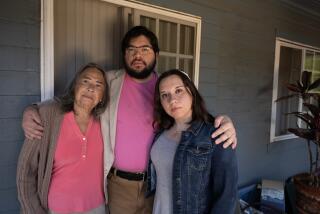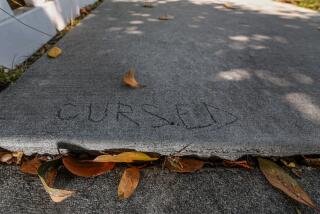Tagging: Youâre It
My neighbors and I in Anaheim enjoy a beautiful park next to our homes. This past week it hasnât been so beautiful.
One or more anti-Fourth of July revelers spray-painted the bathroom building with ugly orange and black graffiti.
As a reporter, Iâve written dozens of stories about graffiti. But I guess it has to happen to you before you understand the anger and sadness it creates.
This graffiti stood as a ghastly blight.
And, unfortunately, graffiti crime is back on the rise, says Det. Mark Garcia of the Huntington Beach Police Department, who specializes in youth crimes.
Though the nonprofit group Global Unity Against Vandalism reports a decrease in graffiti vandalism nationwide, many Orange County cities I called echoed Garcia. Most have graffiti removal crews operating daily.
âIf you spot graffiti, report it to your cityâs graffiti hotline immediately,â Garcia said. âBut if you catch somebody in the act, call the police immediately.â
A survey of cities throughout the county shows that most cities will remove graffiti within 24 hours, and almost all within 72 hours. Quick action is critical, they all agree.
âItâs the start of the broken-window effect,â said Richard La Rochelle, code enforcement director for the city of Anaheim.
*
The âbroken windowâ theory, made popular by UCLA political science professor James Q. Wilson, suggests that if you allow graffiti to stand, before long other blight begins to dot the neighborhood. That leads to complacency. Then down the road, good neighbors see it as hopeless and move away.
Wilson suggested in a recent magazine interview: âYou have to avoid the first broken window, or all the windows will be broken. This means the police must take very seriously small signs of disorder, such as graffiti.â
To keep neighborhoods free of crime, Wilson adds, itâs important that neighbors first feel safe. And graffiti tears down that comfort zone of safety.
Graffiti vandals share a trait: They want to see their work stand for others to see, said Nilda Berndt, crime prevention officer at the Placentia Police Department.
âThe sooner you take it down, and take it down repeatedly, the quicker they catch on that they might as well move on,â she said.
Thatâs why almost every city in Orange County--and county government itself--has an aggressive graffiti removal program. Some have other weapons for fighting graffiti taggers.
Anaheim, for example, is one city that will pay a reward of up to $500 for information leading to both the arrest and conviction of a graffiti tagger. In the 1990s it paid out close to $90,000 for such information, considered just a tiny percentage of what it would have cost for graffiti removal if those taggers had not been exposed.
Anaheim also signs up volunteers, often senior citizens, who conduct surveillance at locations popular for tagging. In the past four years, 10 such vandals have been convicted based on volunteer surveillance.
But La Rochelle believes one of Anaheimâs most successful programs, used by the courts in other cities too, is to assign convicted taggers to perform their community service by working on graffiti cleanup crews.
When I saw the vandalsâ handiwork at our park, I immediately concluded that the various symbols spray-painted were gang-related. But Iâve since learned that most young taggers who have turned this into a sick sport arenât really gang members; they just use symbols that can be understood by other taggers.
*
The National Crime Prevention Council reports from a nationwide study that only 10% of graffiti comes from gang members. So why are other youths such aggressive taggers?
âItâs a game,â said Berndt of Placentia. âThe tagger declares, âMy work stayed up the longest, and in the most places, so I win the game.â â
Gang-related or not, when you think you live in a tranquil neighborhood, itâs jarring to see that vandals have been co-existing with you all along.
âThe graffiti is a reminder that we donât live in a glass bubble,â Berndt said. âWe live in a county where crime can exist right in your own neighborhood.â
We know most graffiti is the work of youths based on the arrests made. Also, said Peggy Snyder, who heads graffiti removal for Garden Grove, âOur graffiti has shot up this month when the schools let out. Some youth simply donât find enough to do with their time.â
But Global Unity Against Vandalism warns that graffiti tagging can become so addictive that taggers donât stop when they leave their teen years. La Rochelle in Anaheim said that cityâs studies show that five years ago, 64% of the taggers were under 18. But today, he said, itâs about 64% from the ages of 18 to 24.
*
The National Crime Prevention Council makes numerous suggestions for how neighborhoods can help reduce the threat of tagging. A good one is to have some kind of vines growing on the side of public buildings, or establish shrubbery in a way that makes it difficult for taggers to get to buildings. A few others from the council:
* Do not remove graffiti on your own, even if on your private property. The police need to document whatâs there, for future prosecution if your tagger is caught defacing another building.
* When you organize neighborhood cleanups, make sure teens are included. (Snyder of Garden Grove reports that some people have their whole family at work on volunteer graffiti-removal days.)
* If your city does not respond within 24 hours, organize neighbors to convince city officials to speed it up.
* If your city does not have a graffiti hotline with a phone number easy to find, push to get one.
Hereâs one tip I can pass along from my own experience: Donât just assume that because graffiti is so highly visible--as in my neighborhood park--that somebody has already reported it. When it was still there two days later, I called the cityâs Graffiti Hotline and discovered it had not yet been reported. Once the city did know, a removal crew showed up in just a few hours.
âWe believe in the âbroken window,â said Anaheimâs La Rochelle. âRemove it fast. Let neighbors feel safe. If weâre persistent in our response, the tagger will eventually get tired.â
More to Read
Sign up for Essential California
The most important California stories and recommendations in your inbox every morning.
You may occasionally receive promotional content from the Los Angeles Times.










